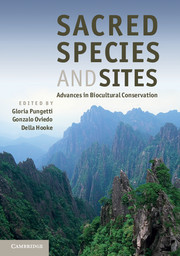Book contents
- Frontmatter
- Contents
- List of Contributors
- Foreword
- Preface
- Acknowledgements
- Introduction
- Part I Concepts and Knowledge
- Part II Sacred Landscapes
- Part III Sacred Sites and People
- Part IV Sacred Species
- 13 The conservation status of sacred species: a preliminary study
- 14 The role of taboos and traditional beliefs in aquatic conservation in Madagascar
- 15 Sacred species of national marine sanctuaries of the United States’ West Coast
- 16 Integrating biocultural values in nature conservation: perceptions of culturally significant sites and species in adaptive management
- Part V Sacred Animals
- Part VI Sacred Groves and Plants
- Part VII Implementation and Conclusions
- Index
- Plate Section
- References
13 - The conservation status of sacred species: a preliminary study
from Part IV - Sacred Species
Published online by Cambridge University Press: 05 August 2012
- Frontmatter
- Contents
- List of Contributors
- Foreword
- Preface
- Acknowledgements
- Introduction
- Part I Concepts and Knowledge
- Part II Sacred Landscapes
- Part III Sacred Sites and People
- Part IV Sacred Species
- 13 The conservation status of sacred species: a preliminary study
- 14 The role of taboos and traditional beliefs in aquatic conservation in Madagascar
- 15 Sacred species of national marine sanctuaries of the United States’ West Coast
- 16 Integrating biocultural values in nature conservation: perceptions of culturally significant sites and species in adaptive management
- Part V Sacred Animals
- Part VI Sacred Groves and Plants
- Part VII Implementation and Conclusions
- Index
- Plate Section
- References
Summary
Introduction
Currently more than 16 000 species are considered threatened with extinction worldwide, out of 41 000 species which have so far been assessed by the IUCN Red List (2007). More than 750 species are already extinct, and 65 species are only found in captivity or cultivation. The protection and conservation of species is paramount, not only to preserve our natural heritage for future generations, but also because species form the ecosystems on which we and all life depend.
In many cultures and faiths throughout the world, certain species are held sacred. Sacredness can mean that an object is exclusively dedicated to a god or religious purpose or is made holy by religious association, or it can signify that an object is safeguarded by religion, reverence or tradition (Allen, 1990). Therefore, sacred species may be protected from human activities which threaten their survival, such as over-exploitation and habitat degradation. This has potential for contributing to a species’ conservation.
In this chapter the results of a pilot study carried out by the Cambridge Centre for Landscape and People on the conservation status of sacred species are presented. This information is used to explore whether being held sacred can protect species from extinction.
- Type
- Chapter
- Information
- Sacred Species and SitesAdvances in Biocultural Conservation, pp. 195 - 206Publisher: Cambridge University PressPrint publication year: 2012



